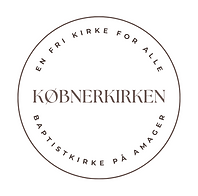The story of Købnerkirken
Købnerkirken – from a small meeting to a caring community on Amager
The history of Købnerkirken goes back to 1861, when a few passionate people from the Baptist Church in Nørrebro (Kristuskirken) came to Amager to hold meetings that told about God's love for the individual. At that time, there was no mission, Sunday school or congregational life on Amager, so in 1868 they started a small Sunday school for 10 children in a private home. This was the beginning of a community and a movement that quickly grew.


In 1887, the Salem Chapel (Salemskapellet) was built by the congregation as a new gathering place for a growing community of faith, with a desire for lively preaching, fellowship, and mission on Amager. Four years later, the Amager Baptist Congregation was founded — with the vision of being an open, caring, and active church for the local area. Under the leadership of the congregation’s visionary pastor, Frederik Bredahl-Petersen (who served from 1932 to 1955), the church became known as a frontrunner — courageous, mission-oriented, and showing God’s love in action in the local community.
The congregation began to take major steps, including becoming the first Baptist church in Denmark to introduce open communion (in 1933), meaning that everyone is welcome to take part in the communion. At the same time, Bredahl-Petersen together with the congregation initiated an ambitious construction project for a new church building, as the Salem Chapel had become too small for the rapidly growing congregation. This required him to travel around Denmark and America to raise funds for the construction, which cost more than the congregation could afford at the time.


Everything succeeded, and in 1939 the present Købnerkirken and Købnerhus I (the church’s apartments) were completed, named after Julius Købner, who helped found the Baptist Church in Denmark. The church quickly became an important meeting place – especially during the war, when the congregation served as a church for resistance fighters, Nazis, communists, and many other groups of people. At the same time, Bredahl-Petersen was very outspoken about the congregation’s rejection of the occupying power and of World War II in general. In secret, Købnerkirkens resistance group, led by Bredahl-Petersen, helped hide weapons, Jews, and persecuted resistance members – among other places in the church’s and Købnerhus’ attic – and assisted in finding funds and safe routes to get them to Sweden.
At the same time, the church was prepared to function as an emergency hospital for the resistance movement. They had gathered food supplies to feed the population of Amager in case of a disaster and had a clear plan for how the congregation would continue to meet in people’s homes if the Germans took over the church. In the years that followed, the congregation organized major relief efforts across Europe — from aid for children in the Netherlands to emergency assistance in Poland and Hungary, as well as aid for the German refugees in the Kløvermarken camp, where more than 100 Germans were baptized into the congregation.


Over the years, Købnerkirkens congregation has experienced both growth and decline. But the congregation has always remained focused on being a church that, in practice, demonstrates God’s love to the local community. As a result, it has run a kindergarten, a scout movement, a youth residence (Købnerhus II), social initiatives, and activities for people of all ages living in the area. Furthermore, the congregation has made it easier to become part of the community through open membership, where baptism is no longer required as a condition for joining (since 2012). Købner Church was also one of the first Baptist churches in Denmark to introduce marriage ceremonies for same-sex couples (in 2014).
Both of these steps were taken to create a more open and welcoming approach, making it a free church for everyone — a place where there is room for everyone around the table and where everyone are welcome to experience God’s love within the church.The story of Købnerkirken is the story of passionate people who, for generations, have believed that one must always love one’s neighbor unconditionally, protect vulnerable minorities, and demonstrate God’s love in action within the local community where the church is located.
Sources used for the history of Købner Church:
-
Baptister på Amager Købnerkirkens baptistmenighed 1891-1991 af Johannes Brixen, Allan Meer og Einar Torstensson
-
De første 50 Aar 1891-1941 af Frederik Bredahl Petersen

Summary
From a small Sunday school in a private home to a prominent free church in the heart of Amager, Købnerkirken has always been driven by courage, love, community, and faith in action. Today, the congregation is an open, inclusive, and diverse community where everyone is welcome — regardless of life situation, background, or sexuality. We strive to be a community where all can experience God’s love and find a place around the table, joining together to be a positive part of our local area. Our vision remains the same as it was 150 years ago: to be a church for the city that brings hope, fosters community, and demonstrates God’s love in action — right in the heart of Amager.
.png)